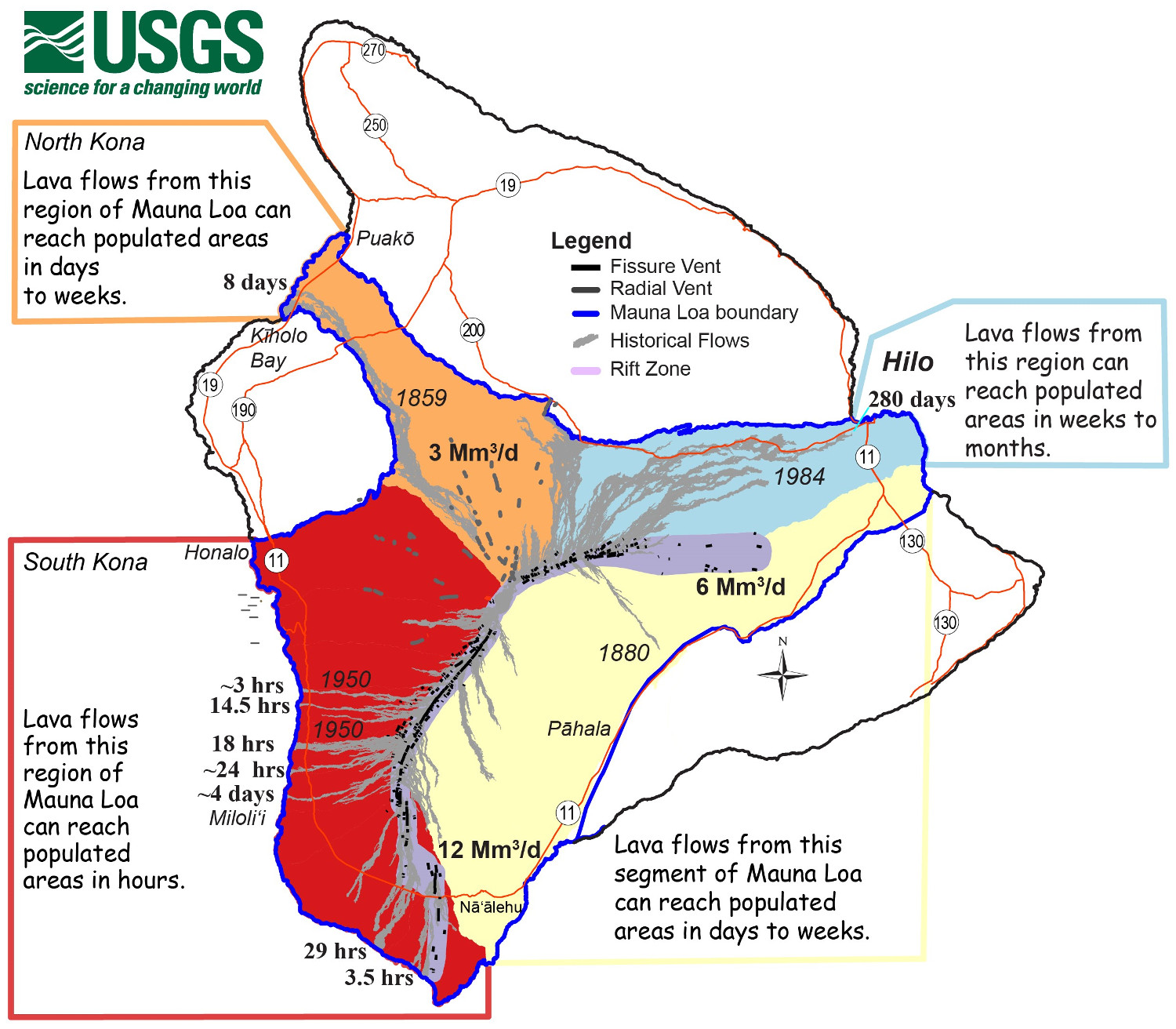(BIVN) – A small earthquake swarm on the southeast flank of Mauna Loa prompted a statement from the USGS Hawaiian Volcano Observatory on Thursday.
Mauna Loa Volcano is not erupting, and scientists said the ongoing earthquakes “do not show any signs of magmatic involvement and are part of normal readjustments of the volcano due to changing stresses within it.”
On the same day as the earthquake swarm, the USGS published its weekly Mauna Loa activity update, reporting “rates of deformation and seismicity at the summit remain slightly elevated and above long-term background levels,” while “other Mauna Loa monitoring data streams show no significant change in deformation rates or patterns that would indicate increased volcanic hazard at this time.”
Mauna Loa, the largest active volcano on Earth, is currently at an ADVISORY alert level. Scientists say this alert level does not mean that an eruption is imminent or that progression to an eruption from the current level of unrest is certain.
UPDATE – (4:30 p.m.) – During the past week, scientists say their seismometers recorded approximately 250 small-magnitude earthquakes below Mauna Loa, 163 of which were below the summit and upper-elevation flanks of the volcano. The majority of the earthquakes were less than M2.5 and occurred at shallow depths of less than 6 km (about 4 mi) below ground level. The Hawaiian Volcano Observatory says these patterns of seismicity are typical of the past several weeks for Mauna Loa.
“Global Positioning System measurements continue to show slow, long-term summit inflation, consistent with magma supply to the volcano’s shallow storage system. A slight increase in the rate of inflation at the summit that began in January is continuing,” the HVO update stated. “Gas concentrations (0 ppm SO2) and fumarole temperatures (below 100 degrees Celsius or 212 degrees Fahrenheit) at both the summit and at Sulphur Cone on the Southwest Rift Zone remain stable.”
Webcam views have shown no changes to the volcanic landscape on Mauna Loa over the past week.
UPDATE – (4:45 p.m.) – Just before 4 p.m. on Thursday, the USGS HVO issued an information statement on the earthquakes, reporting:
On March 18, 2021, the U.S. Geological Survey’s Hawaiian Volcano Observatory (HVO) has recorded over 40 earthquakes beneath the upper Ka‘ōiki seismic zone, about 21 km (13 mi) WNW of Volcano. These earthquakes are occurring in a cluster about 2 km (1 mi) wide and 0.5–6 km (0.5–4 mi) below the surface.
The largest event in the sequence, so far, was a magnitude-3.5 earthquake, with the bulk of the events being less than magnitude-2 and not widely reported by residents. Reported felt events were described as weak shaking, with a maximum Intensity of II on the Modified Mercalli Intensity Scale.
Clustering of shallow earthquakes in this region does not mean an eruption is imminent. HVO has recorded shallow earthquakes in this area for many decades across several eruptive cycles at both Kīlauea and Mauna Loa. These earthquakes do not show any signs of magmatic involvement and are part of normal re-adjustments of the volcano due to changing stresses within it. Other monitoring data streams for Kīlauea and Mauna Loa, including ground deformation, gas, and imagery, show no signs of increased activity.
HVO continues to closely monitor geologic changes, seismicity, deformation, and gas emissions at Kīlauea and Mauna Loa Volcano’s. HVO will issue additional messages and alert level changes as warranted by changing activity.
For more information on earthquakes in the Kaʻōiki Pali area, please see the Volcano Watch article titled, “Why do swarms of earthquakes occur around the Ka‘ōiki Pali?” published by HVO scientists on March 1, 2012.
For information on recent earthquakes in Hawaii and eruption updates, visit the USGS Hawaiian Volcano Observatory website.
HVO is continuing to monitor the earthquake swarm on the southeast flank. Scientists say other Mauna Loa monitoring data streams remain stable and show no signs of increased activity.

(USGS) This map shows the response time people can expect based on Mauna Loa eruptions over the past 200 years. Different sectors around Mauna Loa are colored according to how quickly lava flows can reach populated areas. The warmer the color, the more quickly the flows travel. Mauna Loa lava flows over the past 200 years are shown in gray, and the numbers along the coastline indicate lava travel times to the ocean after the vent(s) opened. Large, bold numbers record the average effusion rates for the different parts of the volcano in millions of cubic meters per day (Mm3/d).
In last week’s Volcano Watch article, scientists encouraged residents living near Mauna Loa to prepare “personal eruption plans” during this time of quiet. In a previous article, scientists said recent earthquake counts “are still lower than observed before past eruptions and have occurred in bursts with periods of quiet in between. We expect that shallow seismic activity will become more sustained—persistent and continuous—before an eruption,” perhaps in the order of hundreds to thousands of earthquakes each day.

by Big Island Video News3:52 pm
on at
STORY SUMMARY
HAWAIʻI ISLAND - Mauna Loa is not erupting, and scientists say an ongoing swarm of earthquakes do not show any signs of magmatic involvement.